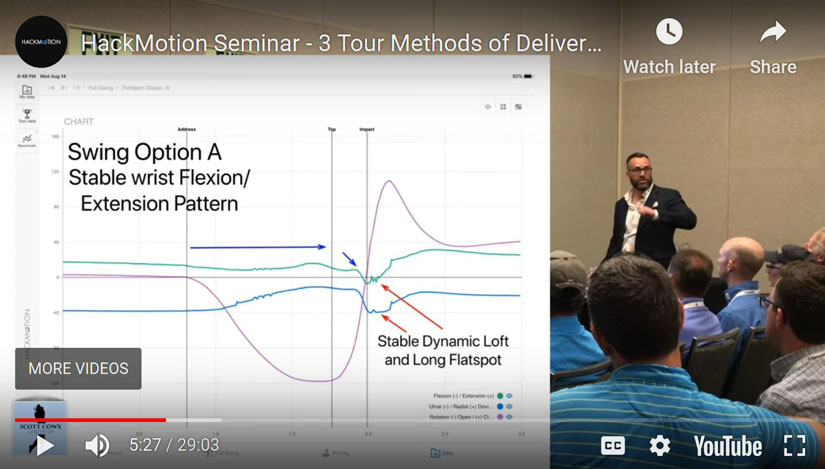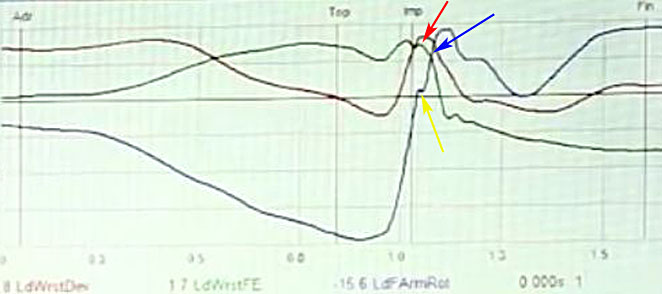Jon,
You have just joined this golf forum and you posted your first post in this thread - and as moderator of this golf forum, I cordially welcome you, and I encourage you to vigorously join any discussion/debate regarding issues related to golf swing biomechanics/mechanics/physics. This golf forum is very different to the Facebook Biomechanics forum hosted by Nick Chertock in the sense that there is zero chance that I (as moderator) will ban you from this forum if you vigously attack another forum member's opinions regarding golf swing biomechanics/mechanics/physics/testing etc. - even if you use strong adjectives such as irrational, insane, nonsensical, stupid, grossly ignorant etc. to emphasize your strong disagreement regarding another forum member's opinion re: golf swing bioemechanics/mechanics/physics in your post. In other words, this a "no holds barred" golf forum from an intellectual perspective - as long as any vehement criticism is related to opinions regarding golf swing biomechanics/mechanics/physics etc. In this lengthy post I will be vigorously attacking your opinions regarding many issues related to golf swing biomechanics and 3D testing because I strongly disagree with so many of your opinions. You are free to respond in kind in a "no holds barred" manner and you can rest assured that you will not be banned from this golf froum no matter how vehemently you express your disagreement regarding any issue related to any topic re: golf swing biomechanics and 3D testing etc.
Although I have started this post by inviting you to debate any issue like the primary issue regarding the value and scientific legitimacy of 3D testing, I actually expect you not to respond with any counterarguments because you do not believe it is worthwhile debating me (who you label as a professional arguer). In your 3rd post in this thread, you wrote-: "
Now that I know which Jeff it is it makes me less interested and sorry I ever responded. He is just a professional arguer and has little credibility with me or most everyone one else in the golf world. Jeff, You can write a book on what ever you want and it would not be anything I would be interested in." Although you have specifically stated that you are not going to be interested in reading this post (or anything else that I write), I am still going ahead with this post because you are not really my primary audience. I am really writing this post for the NGI golf forum members, and guests, who believe it is worthwhile to study and criticise my opinions.
I am not entirely certain why you felt compelled to join this forum in the first place, but I strongly suspect that a major reason is that you want me to publically confess that I was incorrect in my recent post where I analysed JB Holmes' 3D lead wrist flexion-extension velocity graph. You repeatedly harangued me via a number of private e-mail messages by repeatedly asking me when I was going to confess that my analysis was incorrect. You also stated in your original post the following-: "
Although I saw several mistakes made in this thread reading the graphs the one that has the most significance is the one that is posted about JB Holmes. Dr. Mann uses a video done by Michael Finney where Dr. Cheetham pulls up JB Holms swing. Dr. Mann states that JB Holmes is going in to Flexion at 400d/s at impact. This statement is completely backwards. In that graph shown by Dr. Cheetham extension velocity is in the positive direction above the line. This means JB was moving at 400d/s at impact toward extension." To emphasize your opinion that I made a mistake in interpreting that Cheetham-sourced graph, you personally sent me the following graph of another JB Holmes golf swing action as an e-mail attachment.
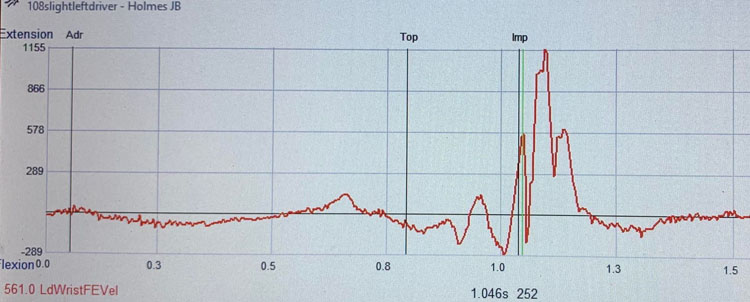
This graph shows J B Holmes' lead wrist flexion-extension velocity graph and it is clearly labelled in such a manner that "extension" is obviously above the zero line, and it therefore clearly shows that the lead wrist is extending pre-impact and reaching an extension velocity of ~400 degrees/ second at impact.
You also claimed that I personally misinterpreted the following Cheetham-sourced 3D graph.
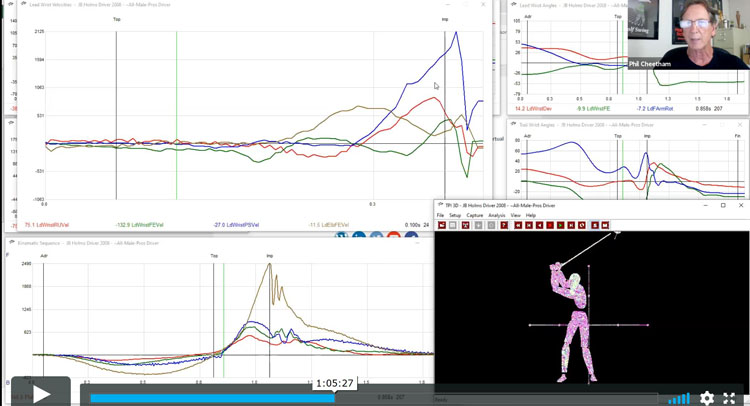
When I analysed that lead wrist flexion-extension velocity graph in my recent post in this thread, I presumed that flexion is above the zero line and all my analytical comments were made based on that assumption. However, my assumption was wrong and you are correct to state that extension is above the zero line. Because my assumption was wrong, my analysis and reasoning is totally wrongheaded and frankly nonsensical. I have no problem admitting that my analysis was grossly incorrect and it is actually the same type of mistake that I made in the recent past when I mixed-up lead forearm supination/pronation. I am obviously slightly embarrassed to admit that I occasionally make these types of avoidable mistakes, but I never try to hide my gross mistakes when I, or another person, subsequently identifies my error.
I will now address two topics - i) why I believe that your 3D graphs are not scientifically valid when it comes to evaluating events in the immediate impact zone (which I have arbitrarily defined as the immediate post-impact zone between P7 and P7.2; and ii) why I believe that your 3D work (as presented in your 2.5 hour Wrist Angles Video, which you sell for $99) can be deemed to be partly worthless from a golf instructional perspective.
I am a strong believer in the potential value of using a DH-hand release action through impact where the clubface remains square to the clubhead arc between P7 => P7.2. It is my strong suspicion that using a DH-hand release action through impact may increase a golfer's ability to more consistently hit straight shots because it may be associated with a low clubface ROC through impact. The alternative to using a DH-hand release action through impact is to use a non-DH hand release action where the lead wrist rapidly extends through the immediate impact zone (flipping subtype of non-DH hand release action) and/or where the lead wrist/hand excessively rolls through impact due to excessive lead forearm supination (rolling subtype of non-DH hand release action). As an useful, but not foolproof, marker that a golfer is using a DH-hand release action, I look at the relationship between the lead forearm and the clubshaft between P7 => P7.2. If a golfer has the clubshaft straight-in-line with the lead forearm at impact and maintains that straight-in-line relationship all the way between P7 => P7.2, then that represents a DH-hand release action. I believe that if the golfer significantly extends (bends) the lead wrist between P7 and P7.2, then he cannot possibly maintain a straight-in-line relationship between the lead forearm and clubshaft during that time period. What is my definition of "significant" when it comes to the degree of "left wrist extending"? I tend to presume that the maximum threshold would be 5 degrees of "lead wrist extending" and I strongly suspect that if the degree of "lead wrist extending" is >5 degrees between P7 and P7.2 then the clubshaft would bypass the lead forearm (from an angular rotational perspective) and produce a non-DH hand release action. Unfortunately, it is not possible to quantitatively measure the degree of "lead wrist extending" happening between P7 and P7.2 by analysing 2D images, and I was hoping that present-day 3D systems (like the TPI-AMM system) could accurately make that measurement.
However, I now believe that it is impossible, because present-day 3D systems have too low a signal/noise ratio to produce a scientifically conclusive result regarding the amount of "lead wrist extending", and/or lead forearm supination, happening between P7 and P7.2.Here is why I harbor that bold-highlighted opinion.
Let's consider that lead wrist flexion-extension velocity graph of JB Holmes golf swing that you sent me.

Note that the graph shows a lead wrist extension velocity of ~478 degrees/second at impact. However, I am not primarily interested in the velocity of "lead wrist extending" happening pre-impact or at impact, and I am mainly interested in accurately quantifying the amount of "lead wrist extending" happening between P7 => P7.2. Note what happens to that lead wrist flexion-extension velocity graph immediately post-impact. It rapidly reverses direction and goes into the flexion zone; then it very rapidly reverses direction again to reach a peak extension velocity value of ~1,155 degrees/second for a short time period before it rapidly reverses direction again. I do not know exactly what part of that post-impact graph represents the immediate impact zone between P7 => P7.2, but how one trust a graph that oscillates so much immediately post-impact? You have claimed (without presenting evidence) that the oscillations seen immediately post-impact is due to ball-collision and/or other unspecified "noise" elements. I do not believe that it is due to ball collision. If it was due to ball collision, then why is it not seen in the Cheetham-sourced graph of J B Holmes's lead wrist flexion-extension velocity graph - see below.
Here is an enlarged image of the Cheetham-sourced graph of J B Holmes's lead wrist flexion-extension velocity graph - focused on the peri-impact time period.
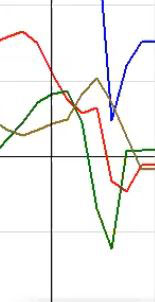
The lead wrist flexion-extension velocity graph (in green) reaches a peak value of ~478 degrees/second of lead wrist extending at impact and then it remains at that same (actually slightly increasing) velocity value for a short time period (? P7 => P7.2 time period) before slowing down. If ball collision routinely causes a marked slowing down of the degree of "lead wrist extending" immediately post-impact then why is it not seen in this 3D graph? Also, why does this graph not show the marked oscillations, that you call "noise? Also, why does this graph go so deep below the zero line into the flexion zone in the later followthrough when that phenomenon is not seen in the JB Holmes graph that you sent me? Also, why does your J B Holmes graph show an increasing "left wrist extending" velocity of 1,155 degrees/second in the later followthrough when it is not present in the Cheetham-sourced graph?
Let's now examine the other lead wrist flexion-extension graph that you posted in this thread.
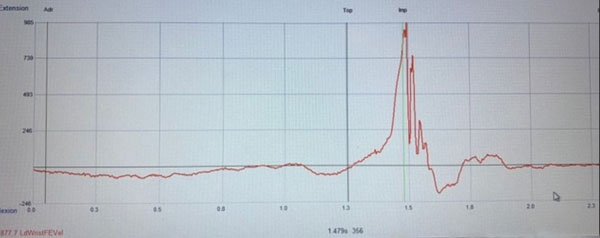
You stated that this pro golfer is a DHer despite having a lead wrist extension velocity of ~877 degrees/second at impact. I don't believe that having a high lead wrist extension velocity at impact incontrovertibly precludes the possibility of the golfer being a DHer because we really need to examine the degree of "lead wrist extending" happening between P7 and P7.2. However, the degree of oscillation of that graph (degree of "noise") immediately post-impact is so large that I think that it cannot possibly be used to accurately measure the velocity of "lead wrist extending" happening between P7 and P7.2.
I personally think that your AMM-3D graphs have far too low a signal/noise ratio when it comes to the P7 => P7.2 time period to produce scientifically accurate results.
Now, I will consider another 3D graph (produced by an unknown 3D system) that measures lead forearm supination - derived from a Tyler Ferrell video.
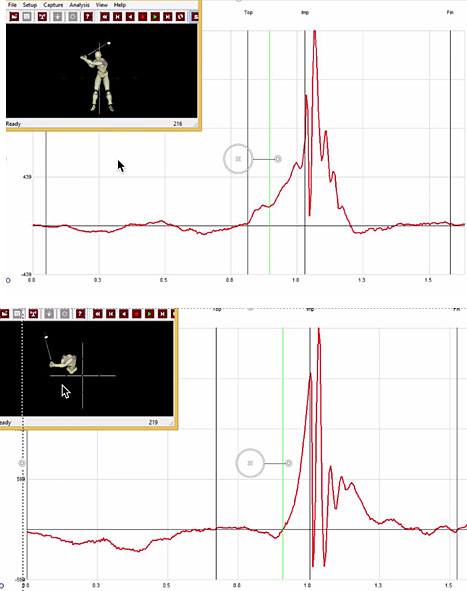
The top graph is of a professional golfer, who Tyler Ferrell claims is using the reverse motorcyle move, while the bottom graph is of an amateur golfer who does not use the reverse motorcyle move thereby accounting for a different pattern of lead forearm supination happening during the downswing. However, look at the graph's immediate post-impact time period and note the marked oscillations (marked amount of "noise). How can any rational person believe that this 3D graph can accurately measure the amount of lead forearm supination happening between P7 => P7.2?
Now, I will consider a HackMotion graph of "lead wrist extending" happening in Dustin Johnson's driver swing action.

This enlarged image only shows the peri-impact time period.
The green graph is his lead wrist flexion-extension graph and flexion is below the zero line.
Note that DJ's lead wrist is flexed in the late downswing, but it is moving towards "lead wrist extending" just prior to impact. Then, it reverses direction temporarily after impact by ~10 degrees before it rapidly starts to again move in the direction of "lead wrist extending" in the later followthrough. I contacted a representative at HackMotion and he claimed that it is a "real life" phenomenon and not an artifact due to ball collision (or some other "noise" factor), even though the sampling rate of the HackMotion device is only 100Hz. I disagree with HackMotion's claim and I do not believe that DJ's lead wrist increasingly flexes by ~10 degrees immediately after impact. If DJ's lead wrist suddenly reversed direction, and increasingly flexed by ~10 degrees, between P7 and P7.2 it would be clearly visible in SwingVision slow motion videos (where the capture rate is >4,000 frames/second).
Here are capture images of DJ's DH-hand release action.
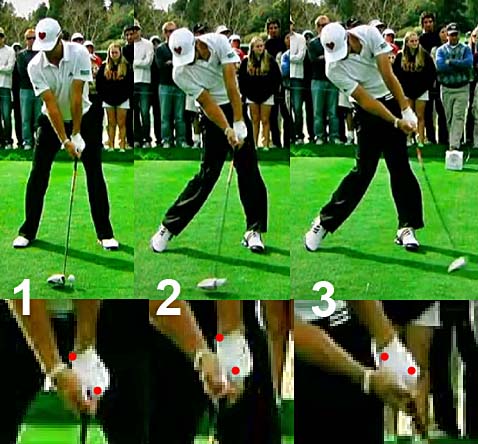
Image 1 is at address, image 2 is at P7 and image 3 is at P7.2.
I have placed red dots at the peripheral end of his lead lower radial bone and over the 2nd metacarpophalangeal (knuckle) joint and there is no visual evidence of 10 degrees of increased "lead wrist flexing" temporarily happening between P7 and P7.2.
At a sampling rate of 100 samples/second, the HackMotion 3D device is only collecting approximately 1 - 1.5 data-samples between P7 and P7.2 and I think that it is impossible for it to accurately reveal that level of granular detail in graphical form (presuming that some proprietary algorithm is used to create a "best fit" graph).
Now, I will consider another 3D system - the GEARS system, which is a camera-based 3D system collecting data at 450 samples/second.
Here is a GEARS video featuring Jamie Sadlowski's driver swing.
Here are capture images from the video.
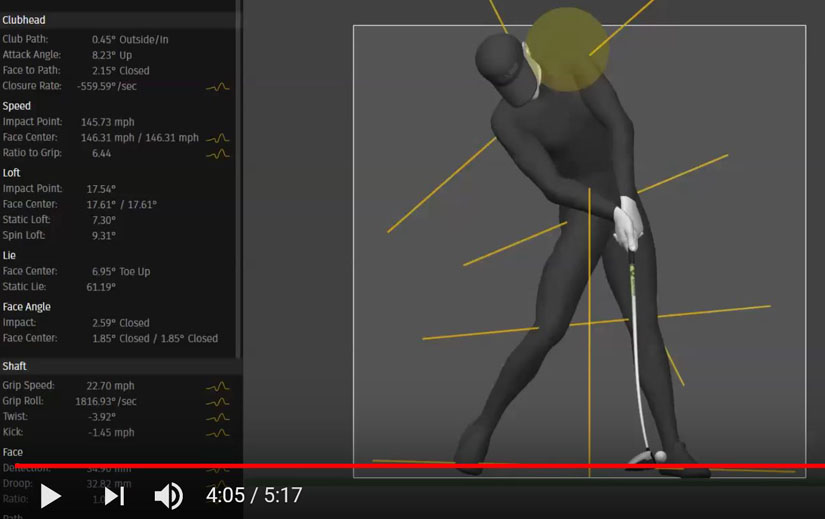
That image shows that GEARS measured a grip roll of ~1,816 degrees/second and a grip speed of 22.7 mph at impact.
However, note that the avatar shows that the back of Jamie's lead wrist/lead hand is facing the target impact!
Here are comparison images - featuring a capture image of Jamie Sadlowski at impact, and the GEARS avatar image of Jamie Sadlowski at impact.

Jamie Sadlowksi routinely uses an ultra-strong (4 knuckle) left hand grip and he therefore always comes into impact with the ulnar border of his lead hand facing the target while the back of his lead wrist/hand is roughly parallel to the swingplane and therefore facing outwards towards the ball-target line (and towards the face-on camera position). By contrast, the GEARS avatar image shows that the back of JS's lead wrist/lead hand is facing the target at impact.
I contacted Michael Neff of GEARS and asked him why the avatar's image was misrepresenting "real life" reality. Michael claimed that his GEARS avatar image was 100% accurately reflective of reality and he claimed that Jamie must have been using a neutral left hand grip on the day that his driver swing was captured by his GEARS 3D system!
Phew!
What more do I need to say about my level of confidence in the GEARS system's ability to accurately evaluate the motion of the lead wrist in the peri-impact zone. I personally don't believe that the GEARS 3D system can accurately measure the degree of "lead wrist extending" happening between P7 => P7.2.
In summary, I believe that present-day 3D systems operate at too low a sampling rate to accurately measure the amount of "lead wrist extending" and/or lead forearm supination happening between P7 => P7.2 and they are also significantly plagued by "noise" elements that create a very low signal/noise ratio.Consider these swing videos captured with a Phantom camera.
John Oda' driver swing captured at 4,000 frames/second where the entire club is seen
John Oda's driver swing captured at 8,200 frames/second where the peripheral club is not visible
When watching the video captured at 4,000 frames/second, it is clearly obvious that the peripheral clubshaft bends backwards due to ball contact. If the lead wrist was also bending back by a significant amount (eg. by ~10 degrees as seen in Dustin Johnson's HackMotion graph) then it would be clearly visible. There is no evidence that ball contact affects the amount of "lead wrist extending" happening between P7 and P7.2.
Here are capture images from Jon Oda's video.
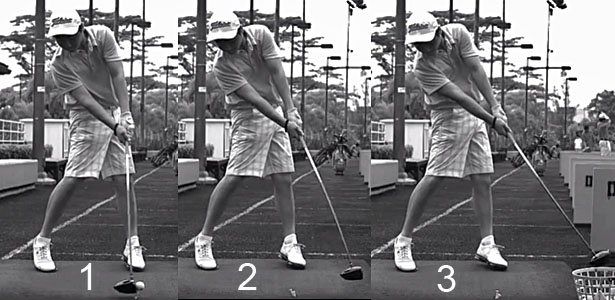
Image 1 is at P7 and image 2 is at P7.2.
One can clearly see that his peripheral clubshaft (which was bent forward just before impact) bends backwards at P7.2. However, there is no visually apparent change in his "lead wrist extending" angle during that P7 => P7.2 time period.
Here are capture images from the P7 => P7.2 time period - captured from the 8,200 frames/second video.

If the Phantom camera is capturing images at 8,200 frames /second, then its sampling rate is 34X the sampling rate of the TPI-AMM 3D system, which has a sampling rate of 240 samples/second. The TPI-AMM 3D system probably only captures about 3 - 4 data-samples between P7 => P7.2, while the Phantom camera is probably capturing 100 - 150 frames between P7 => P7.2. In fact, there were so many frames present in the 8,200 frames/second video, that I only used one-out-of-every-five frames to create that composite image.
Even though one can obviously not quantify the amount of "lead wrist extending" happening from examining 2D images, one can clearly discern that Jon Oda's lead wrist is not rapidly-and-massively extending between P7 => P7.2.
I personally believe that if the golf instructional world wants to use 3D systems to accurately quantify the amount of "lead wrist extending" happening between P7 => P7.2, then they need to have them operate at much higher sampling rates (eg. >4,000 data-samples/second) and they also need to eliminate the significant amount of contaminating "noise" elements present during that P7 => P7.2 time period.
Also, the 3D system's accuracy has to be validated by an external criterion. How do you validate your TPI-AMM 3D system's accuracy? You have claimed that you have used a Phantom camera as a validation tool. Please explain the methodolgy that you used. Also, if you used another criterion tool as a validation tool, then please explain the validation methodology.
If you disagree with my opinions regarding the poor ability of present-day 3D systems in terms of accurately measuring the amount of "lead wrist extending" and lead forearm supination happening between P7 => P7.2, then you are free to present a counterargument.
I will now discuss why I believe that your 3D graphs, as presented in your purchasable Wrist Angles Video, partly misrepresent reality.
Here is a capture image from Larry Rinker's you-tube video (where he interviewed you).
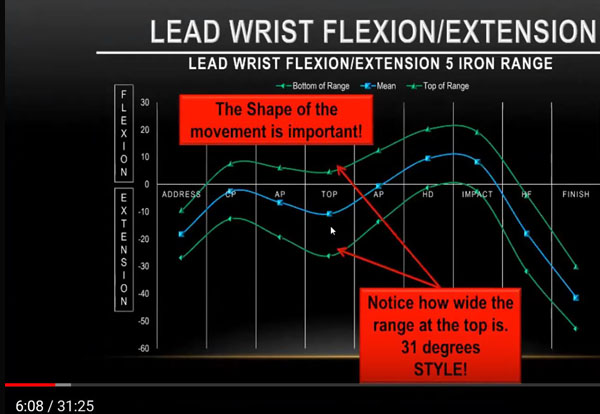
Those "smoothed-out" lead wrist flexion/extension curves show the pattern of motion of lead wrist flexion/extension happening during a full golf swing action. The range of those green curves represent 68% of your study's collection of pro golfers (one standard deviation), and the blue curve represents the mean.
According to your curves, most pro golfers in your study are rapidly-and-massively extending their lead wrist during the early followthrough. I personally believe that those graphs misrepresent reality because they are too smoothed-out and because they do not deal specifically with the P7 => P7.2 time period in a scientifically conclusive manner.
Your 3D graph for lead forearm supination is very similar to the above graph in that it shows that most pro golfers in your study collection are rapidly-and-massively supinating their lead forearm in the early followthrough time period.
Although many pro golfers are rapidly-and-massively extending their lead wrist, and/or rapidly-and-massively supinating their lead forearm, between P7 => P7.2 thereby comprising the subgroup of pro golfers who use a non-DH hand release action through impact, there is also a subgroup of pro golfers who use a DH-hand release action through impact and your video never discusses that subgroup.
Here is my collection of pro golfers who use a DH-hand release action through the immediate impact zone between P7 => P7.2 and many of them even prevent the clubshaft from bypassing their lead forearm (from an angular rotational perspective) to well beyond P7.2 and all the way to P7.4+.
www.perfectgolfswingreview.net/DHers.htmlIn response to those capture images of multiple pro golfers using a DH-hand release action, you stated that you had some of those pro golfers in your study collection, and you claimed that they are all rapidly extending their lead wrist between P7 and P7.2. Where is your "evidence"? If you are using data from your TPI-AMM 3D graphs, then I reject their validity (for reasons already expressed in the first part of this post).
You have claimed that you have never seen a pro golfer who keeps the lead forearm and clubshaft straight-line-aligned for a meaningful length of time, but I believe that it routinely happens if a pro golfer uses a DH-hand release action.
Here is an example - featuring Viktor Hovland.

Image 1 is at impact, image 2 is at P7.1, image 3 is at P7.2, image 4 is at P7.3 and image 5 is at P7.4.
I have drawn a red line along his left lower radial bone in his lower left forearm and a blue line along his proximal clubshaft.
It is obvious to me that his clubshaft is straight-line-aligned with his left lower radial bone all the way between P7 => P7.4 and that he is not allowing his clubshaft to bypass his lead forearm (from an angular rotational perspective). Between P7 => P7.4 he is rotating the back of his lead hand counterclockwise and it is due a finite degree of external rotation of his left humerus combined with a small degree of lead forearm supination, but the total amount of lead hand rotation has to be small enough to allow him to keep his clubface square to his clubhead arc all the way between P7 => P7.4. It is also obvious to me that Viktor is not rapidly-and-massively extending his lead wrist between P7 => P7.4. In fact, I think that the degree of "lead wrist extending" that is happening between P7 => P7.4 must be significantly <10 degrees - how can it be greater if the clubshaft and lead forearm remain straight-line-aligned?
If you disagree with me, then please present a scientifically sound counterargument that explains how two conjoined levers (representing the lead arm/forearm and clubshaft) rotating around a single fulcrum point (left shoulder joint) can remain straight-line-aligned (from an angular rotational perspective) between P7 => P7.2 if the hinge joint between the two conjoined levers is rapidly moving in the direction of "extending" by >5 degrees during the P7 => P7.2 time period.
By the way, if you strongly disagree that Viktor Hovland's clubshaft is remaining straight-line-aligned with his lead forearm between P7 => P7.4, then we operate in two different mental universes where we perceive each other's "facts" as being "alternative facts" (untruths).You, and many other golf instructors (like Brian Manzella and Mike Malaska and Robert Baker), believe that trying to keep the clubshaft straight-line-aligned with the lead forearm (by avoiding a large amount of "left wrist extending" happening between P7 => P7.2+) would be a great disadvantage because you perceive that it would decrease a pro golfer's ability to generate a maximum level of clubhead speed through impact.
Consider your statement in your original post, where you stated "
First imagine; Swinging a club slowly where you would be flexing your lead wrist through impact. Maybe hold a club and do it so you can feel what is going on. Then ask yourself “Is this really what I would want to happen while trying to hit a ball as far as possible?”. Or would you want to do it like JB Holmes and allow that wrist to move toward extension at 400d/s knocking the stuffing out of the ball? I think you will all see the error in this thought. Then also imagine your wrist is moving at 400d/s toward extension. Do you think in your wildest dreams your shaft would stay pointed at your lead forearm? Do you think your wrist would suddenly stop and hold that position with a club effectively weighing 100 lbs at impact?"
First of all, you should not be comparing a lead wrist that is moving towards "increased lead wrist flexion" to a lead wrist extending at 400 degrees/second in your comparison because a DHer does not increasingly flex his lead wrist between P7 => P7.2. You are mistakenly referring to a handle-dragging technique, which is very different to an intact LAFW/GFLW technique that is associated with a DH-hand release action. See this review paper to become aware of the difference -
perfectgolfswingreview.net/VP12.html . You should really be comparing the velocity of "lead wrist extending" happening between P7 => P7.2 between a DHer (who has a slower rate of "lead wrist extending" velocity that will cause <5 degrees of "lead wrist extending" happening between P7 => P7.2.) and a non-DHer (who has a rapid rate of "lead wrist extending" of 400 degrees/second). Secondly, you really should be using pro golfers, who use a weak-neutral left hand grip, in your comparison because they will have their lead wrist/hand facing the target at impact and between P7 => P7.2.
It makes no sense to use J B Holmes an example - for the following reasons.
J B Holmes uses a very strong left hand grip, which means that the back of his lead wrist is not facing the target at impact.
Here are capture images showing J B Holmes' lead wrist alignment/motion through impact to P7.2.
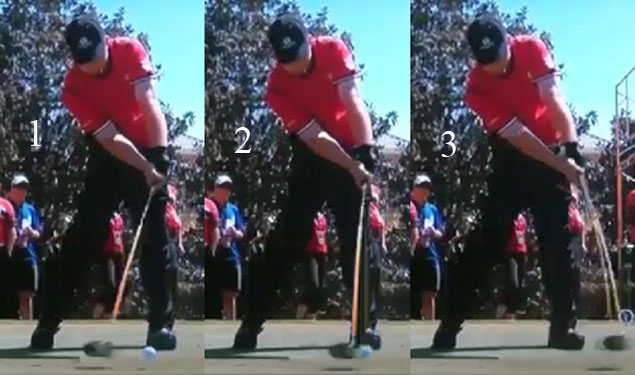
Image 1 is P6.9, image 2 is at P7 and image 3 is at P7.2.
Note that the back of his lead wrist/hand is roughly parallel to the swingplane, and not perpendicular to the swingplane, near/at impact. Due to a finite amount of lead forearm supination/lead humerus external rotation happening between P7 => P7.2, the back of his lead wrist/hand gets to face more towards the target by P7.2. Therefore, rapid lead wrist extension will not necessarily increase the speed of his clubshaft through impact because the "lead wrist extending" phenomenon is not moving in the same parallel direction as the clubhead, but it is moving at an angle that is more perpendicular to the swingplane rather than being more parallel to the swingplane.
You also mentioned that the lead wrist's extending phenomenon will be affected by the fact that the clubhead is effectively weighing 100lbs at impact. However, the 100lbs figure really refers to the outward pull of the clubhead that is operating roughly straight-in-line with the longitudinal axis of the left arm, and that CF-force is operating at roughly a 90 degree angle to the direction of the clubhead's motion towards the target. Why will that 100lb centrifugal pull at impact significantly affect the rate of "lead wrist extending" happening between P7 => P7.2?
Now, let's consider how much lead wrist extending will likely happen between P7 => P7.2 if the lead wrist is continuously extending at a rate of 400 degrees/second during that time period and if the clubhead travels a distance of 2 feet between P7 and P7.2.
The average tour pro swings the driver at 113 mph and let's presume that the clubhead speed is reduced by 20% at impact, which would mean a clubhead speed of about 90 mph = 132 feet/second post impact.
132 feet is equivalent to 1 second.
If the clubhead travels approximately 2 feet post impact between P7 and P7.2 (when moving at a speed of 90mph), the time taken would be approximately (1/132) x 2 = 0.015 secs.
If the lead wrist is continuously extending at 400 degrees/second during that 0.015 seconds time period, then how much will it extend between P7 => P7.2 (presuming that it is extending in a direction that is parallel to the clubhead path direction)?
The answer is 400 x 0.015 = 6 degrees.
Let's arbitrarily presume that a DHer has a slower speed of "left wrist extending" of 2 degrees between P7 => P7.2. Do you really believe that having an extra 4 degrees of "left wrist extending" happening between P7 => P7.2 will significantly increase a pro golfer's clubhead speed through the immediate impact zone?
I believe that it is a fallacy to believe that a more rapid lead wrist extending amount of ~4 degrees between P7 and P7.2 will allow a golfer to generate a higher clubhead speed at impact (compared to a DHer).
Here are two pro golfers, who are DHers, and who are among the longest drivers on the PGA tour.
Cameron Champ

Bryson DeChambeau
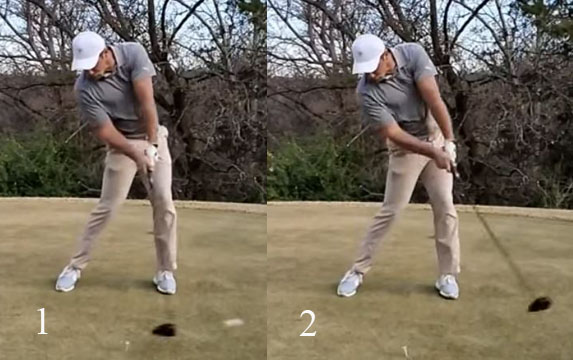
Although I do not know their precise amount of "lead wrist extending" happening between P7 => P7.2, I certainly suspect that it is <6 degrees, which means that their lead wrist extending velocity is definitely <400 degrees/second. Do you really believe that the difference between their "real life" lead wrist extending velocity and a lead wrist extending velocity of 400 degrees/second is significant, and do you really believe that they would hit the ball further if they allowed their lead wrist to continously extend at a velocity of 400 degrees/second between P7 and P7.2?
Finally, I will discuss your behaviour regarding my use of copies of images from your purchasable Wrist Angles Video.
I used about 10 copies of images from your purchasable video on wrist angles in a number of different posts in this thread. In response, I received the following e-mail communication from you where you stated-: "
I have now reviewed your entire thread. You have used material from my Wrist Angle Video without my consent. This material is protected by the Copyright Laws. This email is to inform you that I am insisting you take down all of this material immediately."
Why would you adamantly insist that I not use copies of images from your Wrist Angles Video, and why do you believe that it is against the copyright law?
Here is a Wikipedia article on the fair-use doctrine that applies to the copyright law -
en.wikipedia.org/wiki/Fair_useThe fair use doctrine clearly states that it is permissible for me to use a limited amount of your copyrighted material without prior permission if it is used for a non-profit educational purpose. I derive no financial income as a moderator of the NGI golf forum and I have never earned a cent from writing review papers for my golf website at
perfectgolfswingreview.net/ . So, I am obtaining no financial gain from using a limited amount of copyrighted material.
I have frequently used copyrighted images when I have written review papers for my golf website.
For example, I used copies of copyrighted images in this book review paper on David Leadbetter's "A Swing" book at
www.perfectgolfswingreview.net/aswing.htmlI also used many copies of copyrighted images in my book review paper on Brandel Chamblee's "Anatomy of Greatness" book at
www.perfectgolfswingreview.net/chamblee.htmlI also used many copies of copyrighted images in my critical analsis review paper of Phil Cheetham's PhD dissertation paper at
perfectgolfswingreview.net/Cheetham.htmNone of those authors objected to my use of a limited amount of copied copyrighted images because they presumably knew that I was legally entitled to use them according to the dictates of the fair-use doctrine.
You are the
first person who has ever demanded that I remove copies of copyrighted images from either my golf website or the NGI golf forum. What is your true motivation?
You also revoked my access to your purchasable Wrist Angles Video even though I paid for that access. You did not inform me that you had revoked that access and I found out just by chance when I recently decided to again access that video. When I inquired by e-mail why I had lost access to that video, you stated that it was because I used your copyrighted material without your prior permission. How do you explain that type of revoking action? Do you really think that my losing access to your Wrist Angles Video would prevent me from writing a review paper on your Wrist Angles Video? I have already copied a sufficient number of images from your Wrist Angles Video to write a review paper, and I may decide to write a review paper this winter. The fair-use doctrine will obviously protect me from a legal perspective if I decide to write that review paper, so your recent revoking action makes no sense to me.
Therefore, the fundamental question remains - why are you so protectively defensive about my use of a limited amount of copies of your copyrighted material from your Wrist Angles Video? In the absence of a rational answer, I can imagine that many people are going to imagine that you are too thin-skinned to accept any negative criticism of your opinions on the topic of wrist angles.
Finally, although we do not agree on many issues relating to the topic of wrist angles through impact, we 100% agree regarding one statement that you made in your last post.
In your last post in this thread, your last comment was "
The facts are the facts and you can believe what you want".
I fully agree with that statement!
Jeff.
(aka "Imperfect Golfer" and "Dr.Mann" in the NGI golf forum)


















